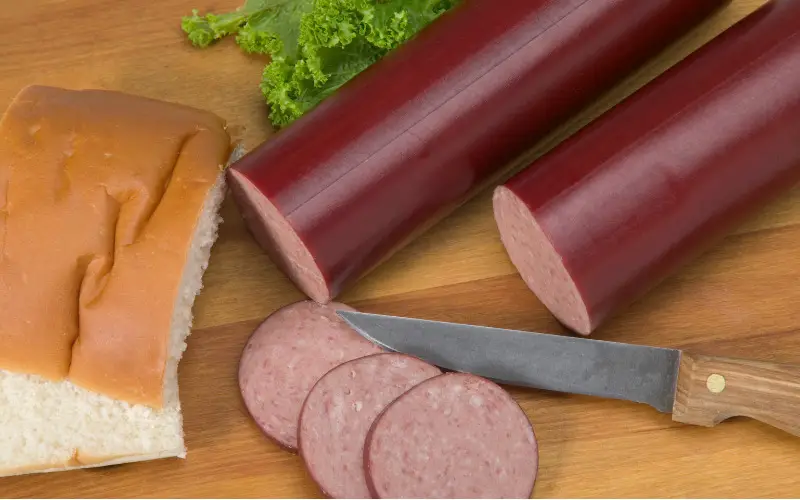Summer sausage and salami are similar in taste, appearance, texture, and they can both be enjoyed with a bottle of beer or a glass of wine. But then, come to think of it, what is the difference between a summer sausage and salami?
The significant difference between these two is that salami has a lower moisture content than summer sausage.
This article will dive further into the differences between them, what goes best with them, and all your frequently asked questions.
What Is Summer Sausage?

Summer sausage days back hundreds of years (or more) ago when German immigrants were looking for a way to preserve their sausage.
The sausages are preserved by fermentation; this lowers the pH level of the sausage and slows the growth of bacteria.
Curing salts that contain sodium chloride and sodium nitrate is used to prevent the growth of bacteria and prevent your meat from going bad.
The fermentation process is done by adding lactic acid to your meat, which hinders the growth of bacteria and gives your sausages a tangy taste.
Modern days refer to it as sausage because it can be kept outside the fridge without opening; a common form of summer sausage is smoked or dried sausage.
Summer sausage still needs to be refrigerated. While a few summer sausages are shelf-stable, most of them need to be refrigerated because they are semi-dry; it is advisable to leave your summer sausage in the fridge for up to one month.
Summer sausage is a mixture of ground pork and beef; sometimes, venison can be used in place of beef. It can include seasonings like garlic, salt, black pepper, and mustard seed, the herbs combined with the preservative give the sausage a unique taste.
Read Also: How to Tell if Brats are Done on Grill Without a Thermometer
What To Eat With Summer Sausage
So far, cheese is the best pairing for summer sausage. Although not all cheese will taste great with it, you should consider using creamy cheese with fat to balance the acidity of summer sausage.
Smooth cheese like Muenster, butterkase, and Havarti will contrast to a summer sausage salty, hard and tangy flavor; sharp cheddar and swiss cheese can also be considered a good option.
Beer is not a bad idea either! Since summer sausage originated in Germany, neighboring countries brew beer that can match the taste of this hard sausage; sour ale or stout is the ideal beer to accompany this delicacy.
Red or white wine is also ideal for summer sausage. Chardonnay can be paired up with mild cheese, while Gewürztraminer can be paired with swiss cheese, red wine like Beaujolais, cabernet sauvignon, and merlot will go great with Havarti, butterkase, and muenster.
Some easy dishes can be prepared using summer sausage; they include,
- Summer sausage sliders
- Pasta salad with summer sausage and grilled vegetables
- Summer sausage jalapeño poppers
- Keto summer sausage cucumber bites with cream cheese mousse
- Roasted potato and summer sausage fan.
Summer Sausage Shelf Life
You should examine the label on the packaging of your summer sausage to see information about the shelf life of your summer sausage.
But according to the USDA Food Safety and Inspection Service, a semi-dry summer sausage can last for 1 to 2 weeks in a refrigerator if opened and can last for 1 to 2 months in a freezer. Unopened summer sausage can last up to 3 months in a fridge.
Thawed summer sausage should be consumed immediately; this is because, at room temperature, your summer sausage will only last for a few hours before turning bad. Follow storage instructions and heed the best before the date for maximum food safety.
What Is Salami?

Salami is Latin for salt; it dates back to Roman times as it originates from Italy. It can be found mainly in the Southern and Eastern parts of Europe; central Europe is also included.
Salami is cured meat; it was initially made of pork, but now different types of meat like lamb, venison, duck, and other varieties of meat.
Salami is made by mixing equal promotion of finely ground meat with curing salt and seasoning like black pepper and garlic. After a successful mixture, your salami is packed into a long case that allows it to ferment for days and even months.
Types Of Salami
There are different types of salami that it becomes complicated to tell them apart. Knowing the difference between the types of salaries allows you to explore them all.
Genoa salami
Just as its name implies, this type of salami originates from the Genoa region in Italy. This salami contains a lot of garlic and can be made with basic ingredients like salt, sugar, garlic, seasoning, and pork.
Sopressata
Sopressata originated in Italy but is now adored in the United States by Americans. You have the option of having soppressata in a mild or spicy flavor; it can be made of pork, sea salt, sugar, and spices. This salami can be paired with wine, beer, or crackers with seed.
Pepperoni
His Italian cured meat is an American-borne phenomenon. It has gained popularity for being one of the most well-known pizza toppings, appearing in about 35% pizza recipes. Pepperoni salami is known for its rich and smoky flavor, and it can be paired well with a green salad or your favorite pizza.
Wine salami
Just as its name implies, this salami is made of wine. Wine is infused into the salami to improve its flavor and give it a better texture; this combination is excellent since almost all salami tastes great with wine. Wine salami contains wine, sugar, garlic, salt, and other spices; it goes well with soft cheese and crackers.
Chorizo
Chorizo is Spanish based salami that has a dry and rich flavor. There are two types of chorizo, Mexican and Spanish chorizo.
The Mexican chorizo is made of ground pork, usually served raw and uncooked, while Spanish chorizo is made of ground pork that is cured and sold. Spanish chorizo is considered a type of salami, while Mexican chorizo is not.
Finocchiona salami
This salami emanated from Tuscan; back then, the people of this region believed that pepper was too expensive. So they replaced pepper with a spice called finocchiona, which is Italian for fennel; this spice is perfect for enhancing the taste and aroma of the salami. Finocchiona salami is made of pork, fennel, seasoning, garlic, and salt.
Felino salami
This salami emanated from a small town in Italy called “felino.” This salami has a smooth texture and a rich flavor that contains peppercorns and wine. It is recommended that you cut this salami ⅛ inches thick to ensure that the flavors are balanced.
Cacciatore salami
This salami is usually called “hunters salami” because Italian hunters widely prefer it. It is not too spiced with garlic and black pepper to give it a fantastic flavor. This salami also has some nutritional value that helps the body stay healthy.
Peppered salami
This salami is packed with black peppers to give it a hot and spicy flavor. This salami goes well with your favorite cheese or chianti; you can also take it with wine.
What To Eat With Salami
A lot of things can go with salami to make a tasty snack. You can pair up salami with varieties of cheese, bread, wine, crackers, salads, beer, pizzas, olive, and cold ale. There is still more accompaniment that can go well with salami.
You also have dishes prepared with salami; they include sandwiches, salami pasts, chickpea salad with salami and giardiniera dressing, and salami and egg mishmash. For more salami dishes, read this article.
Difference Between Summer Sausage And Salami
While summer sausage and salami are similar in a lot of ways, they are also different from each other. Summer sausage loses only 15% of its moisture content during drying, while salami loses about 25%. This means salami has a lower moisture content than summer sausage.
Salami has a longer shelf life compared to summer sausage. This is because salami has lost more moisture than summer sausage; salami has a shelf life of 3 to 6 weeks.
Conclusion: Summer Sausage vs Salami
Summer sausage and salami may seem alike in many ways, but their moisture content tells them apart. But these meat delicacies can be enjoyed in several ways and can be included in different dishes.
There are different types of salami, most of which are of Italian origin. These salamis can be used with different accompaniments, further intensifying their rich flavor.
For maximum food safety, it is advisable to check the best before date and storage options in your summer sausage or salami; you should not leave an unthawed salami or summer sausage for a long time as it may start to go wrong due to bacteria action.
You May Also Like:
- 3 Simple Ways to Thaw Frozen Ribs
- How to Crack Hickory Nuts Easily
- Is Kiln Dried Wood Safe to Burn?
- 6 Ways to Put a Fire Pit on a Wooden Deck
- How Do You Make a Square Fire Pit Insert? (12 Easy Steps)
- 4 Best Fire bowls You Should Choose From
We trust this article helped you know the difference between Summer Sausage vs Salami. You may also want to check out: How to Tell if Brats are Done on Grill Without a Thermometer.
Thanks for taking the time to read our article, and we hope you find it helpful. Would you mind leaving a comment below if you have any suggestions?
Kindly reach out to people by sharing this post on social media.
If you liked this article, then please follow us on Facebook, Instagram, and Pinterest.

